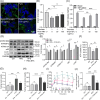Acidic Nanoparticles Restore Lysosomal Acidification and Rescue Metabolic Dysfunction in Pancreatic β-Cells under Lipotoxic Conditions
- PMID: 38830624
- PMCID: PMC11192035
- DOI: 10.1021/acsnano.3c09206
Acidic Nanoparticles Restore Lysosomal Acidification and Rescue Metabolic Dysfunction in Pancreatic β-Cells under Lipotoxic Conditions
Abstract
Type 2 diabetes (T2D), a prevalent metabolic disorder lacking effective treatments, is associated with lysosomal acidification dysfunction, as well as autophagic and mitochondrial impairments. Here, we report a series of biodegradable poly(butylene tetrafluorosuccinate-co-succinate) polyesters, comprising a 1,4-butanediol linker and varying ratios of tetrafluorosuccinic acid (TFSA) and succinic acid as components, to engineer lysosome-acidifying nanoparticles (NPs). The synthesized NPs are spherical with diameters of ≈100 nm and have low polydispersity and good stability. Notably, TFSA NPs, which are composed entirely of TFSA, exhibit the strongest degradation capability and superior acidifying properties. We further reveal significant downregulation of lysosomal vacuolar (H+)-ATPase subunits, which are responsible for maintaining lysosomal acidification, in human T2D pancreatic islets, INS-1 β-cells under chronic lipotoxic conditions, and pancreatic tissues of high-fat-diet (HFD) mice. Treatment with TFSA NPs restores lysosomal acidification, autophagic function, and mitochondrial activity, thereby improving the pancreatic function in INS-1 cells and HFD mice with lipid overload. Importantly, the administration of TFSA NPs to HFD mice reduces insulin resistance and improves glucose clearance. These findings highlight the therapeutic potential of lysosome-acidifying TFSA NPs for T2D.
Keywords: Type 2 diabetes (T2D); V-ATPase; acidic nanoparticles; autophagic degradation; insulin secretion; lysosomal acidification; mitochondrial function.
Conflict of interest statement
The authors declare the following competing financial interest(s): M.W.G., O.S.S., and J.Z. have jointly invented and hold a patent (Patent number: US10925975B2) registered with the United States Patent and Trademark Office. This patent focuses on the utilization of acidic nanoparticles as a therapeutic approach for diseases characterized by compromised lysosomal acidity. O.S.S. and M.W.G. are also co-founders of Enspire Bio/Capacity Bio, which are testing the application of these acidic nanoparticles. The remaining authors declare no additional competing interests.
Figures






References
-
- International Diabetes Federation, IDF Diabetes Atlas, 2021.
Publication types
MeSH terms
LinkOut - more resources
Full Text Sources

